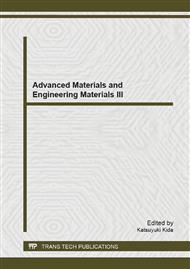p.194
p.201
p.205
p.209
p.213
p.221
p.228
p.235
p.241
Fundamental Research of Guide Sleeves in 3D Weaving Composites
Abstract:
In this study, fundamental research, including material selection and structure design of guide sleeves in 3D weaving composites were investigated by three-point bending test, compression test and SEM observation. The results showed that carbon fiber composite guide sleeves had much higher interface bonding strength than titanium alloy guide sleeves, while worse flexural strength. There were three kind of structure design of the guide sleeves that were groove, rough surface and untreated surface. Compared with the structure of untreated surface, guide sleeves with grooves and with rough surface exhibited higher interface bonding strength, due to increasing the contact area between the guide sleeve and resin. But the guide sleeves with rough surface took the advantages of more simple to preparation and lower cost than those with the grooves. Furthermore the structure of groove could damage the flexural behavior of the guide sleeves.
Info:
Periodical:
Pages:
213-220
Citation:
Online since:
February 2014
Authors:
Keywords:
Price:
Сopyright:
© 2014 Trans Tech Publications Ltd. All Rights Reserved
Share:
Citation:


